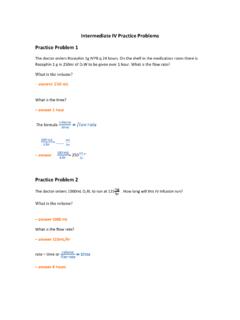Transcription of The Practice of System and Network Administration
1 The Practice of System andNetwork AdministrationSecond EditionThis page intentionally left blank The Practice of Systemand NetworkAdministrationSecond EditionThomas A. LimoncelliChristina J. HoganStrata R. ChalupUpper Saddle River, NJ Boston Indianapolis San FranciscoNew York Toronto Montreal London Munich Paris MadridCapetown Sydney Tokyo Singapore Mexico CityMany of the designations used by manufacturers and sellers to distinguish their products areclaimed as trademarks. Where those designations appear in this book, and the publisher wasaware of a trademark claim, the designations have been printed with initial capital letters orin all authors and publisher have taken care in the preparation of this book, but make no ex-pressed or implied warranty of any kind and assume no responsibility for errors or liability is assumed for incidental or consequential damages in connection with or arisingout of the use of the information or programs contained publisher offers excellent discounts on this book when ordered in quantity for bulk pur-chases or special sales, which may include electronic versions and/or custom covers and contentparticular to your business, training goals, marketing focus, and branding interests.
2 For moreinformation, please Corporate and Government Sales, (800) 382-3419, sales outside the United States please contact:International Sales, us on the Web: of Congress Cataloging-in-Publication DataLimoncelli, Practice of System and Network Administration / Thomas A. Limoncelli, Christina , Strata R. Chalup. 2nd bibliographical references and : 978-0-321-49266-1 (pbk. : alk. paper)1. Computer networks Management. 2. Computer Hogan, Christine. II. Chalup, Strata R. III. dc222007014507 Copyrightc 2007 Christine Hogan, Thomas A. Limoncelli, Inc., and rights reserved. Printed in the United States of America. This publication is protectedby copyright, and permission must be obtained from the publisher prior to any prohibitedreproduction, storage in a retrieval System , or transmission in any form or by any means,electronic, mechanical, photocopying, recording, or likewise. For information regarding per-missions, write to:Pearson Education, and Contracts Department75 Arlington Street, Suite 300 Boston, MA 02116 Fax: (617) 848-7047 ISBN 13: 978-0-321-49266-1 ISBN 10:0-321-49266-8 Text printed in the United States on recycled paper at RR Donnelley in Crawfordsville, Indiana.
3 Seventh printing, February 2012 Contents at a GlancePart IGetting Started1 Chapter 1 What to Do 2 Climb Out of the Hole27 Part II Foundation Elements39 Chapter 3 Workstations41 Chapter 4 Servers69 Chapter 5 Services95 Chapter 6 Data Centers129 Chapter 7 Networks187 Chapter 8 Namespaces223 Chapter 9 Documentation241 Chapter 10 Disaster Recovery and Data Integrity261 Chapter 11 Security Policy271 Chapter 12 Ethics323 Chapter 13 Helpdesks343 Chapter 14 Customer Care363 Part III Change Processes389 Chapter 15 Debugging391 Chapter 16 Fixing Things Once405 Chapter 17 Change Management415 Chapter 18 Server Upgrades435 Chapter 19 Service Conversions457 Chapter 20 Maintenance Windows473 Chapter 21 Centralization and Decentralization501vviContents at a GlancePart IV Providing Services521 Chapter 22 Service Monitoring523 Chapter 23 Email Service543 Chapter 24 Print Service565 Chapter 25 Data Storage583 Chapter 26 Backup and Restore619 Chapter 27
4 Remote Access Service653 Chapter 28 Software Depot Service667 Chapter 29 Web Services689 Part V Management Practices725 Chapter 30 Organizational Structures727 Chapter 31 Perception and Visibility751 Chapter 32 Being Happy777 Chapter 33 A Guide for Technical Managers819 Chapter 34 A Guide for Nontechnical Managers853 Chapter 35 Hiring System Administrators871 Chapter 36 Firing System Administrators899 Epilogue909 Appendixes911 Appendix A The Many Roles of a System Administrator913 Appendix B Acronyms939 Bibliography945 Index955 ContentsPrefacexxvAcknowledgmentsxxxvAbo ut the AuthorsxxxviiPart I Getting Started11 What to Do Building a Site from Growing a Small Going Replacing Moving a Data Moving to/Opening a New Handling a High Rate of Office Assessing a Site (Due Diligence) Dealing with Mergers and Coping with Machine Surviving a Major Outage or Work What Tools Should Every Team Member Have? Ensuring the Return of Why Document Systems and Procedures?
5 Why Document Policies? Identifying the Fundamental Problems inthe Getting More Money for Getting Projects Keeping Customers Keeping Management Keeping SAs Keeping Systems from Being Too Coping with a Big Influx of Coping with a Big Influx of New Coping with a Big Influx of New Handling a High SA Team Attrition Handling a High User-Base Attrition Being New to a Being the New Manager of a Looking for a New Hiring Many New SAs Increasing Total System Decreasing Adding Stopping the Hurt When Doing This Building Customer Building the Team s Improving the Team s Handling Ethics My Dishwasher Leaves Spots on My Protecting Your Getting More Setting Your Getting All the Work Avoiding What Should SAs Expect from Their Managers? What Should SA Managers Expect from Their SAs? What Should SA Managers Provide to Their Boss?262 Climb Out of the Tips for Improving System Use a Trouble-Ticket Manage Quick Requests Adopt Three Time-Saving Start Every New Host in a Known Follow Our Other Conclusion36 ContentsixPart II Foundation Elements393 The Loading the Updating the System Software and Network Avoid Using Dynamic DNS with The High Confidence in Involve Customers in the Standardization A Variety of Standard Conclusion674 The Buy Server Hardware for Choose Vendors Known for Reliable Understand the Cost of Server Consider Maintenance Contracts and Spare Maintaining Data Put Servers in the Data Client Server OS Provide Remote Console Mirror Boot The Enhancing Reliability and Service An Alternative.
6 Many Inexpensive Conclusion925 The Customer Operational Open Vendor Machine Restricted Single or Multiple Centralization and Service The Dedicated Full Dataflow Analysis for Conclusion1266 Data The Power and Fire Console Tools and Parking The Greater More Ideal Data Tom s Dream Data Christine s Dream Data Conclusion185 Contentsxi7 The The OSI Clean Network intermediate Distribution Main Distribution Demarcation Simple Host Network Overlay Number of Standards-Based Single Administrative The Leading Edge versus Multiple Administrative Constants in Things That Change in Network Design2208 The Namespace Namespace Change Centralizing Namespace The One Huge Further Customer-Based Leveraging Conclusion2399 The What to A Simple Template for Getting Easy Sources for The Power of Storage Wiki A Search Rollout Self-Management versus Explicit The A Dynamic Documentation A Content-Management A Culture of Taxonomy and Additional Documentation Off-Site Conclusion25810 Disaster Recovery and Data The Definition of a Risk Legal Damage Data The Redundant Security Media Conclusion26911 Security The Ask the Right Document the Company s Security Basics for the Technical Management and Organizational The Make Security Stay Current.
7 Contacts and Produce Organization Small Medium-Size Large E-Commerce Conclusion32112 The Informed Professional Code of Customer Usage Privileged-Access Code of Copyright Working with Law The Setting Expectations on Privacy and Being Told to Do Something Conclusion34013 The Have a Offer a Friendly Reflect Corporate Have Enough Define Scope of Specify How to Get Define Processes for Establish an Escalation Define Emergency in Supply Request-Tracking The Statistical Out-of-Hours and 24/7 Better Advertising for the Different Helpdesks for Service Provision and Problem Resolution Conclusion36014 Customer The Phase A/Step 1: The Phase B: Problem Phase C: Planning and Phase D: Perils of Skipping a Team of The Based Holistic Increased Customer Special Announcements for Major Trend Customers Who Know the Architectural Decisions That Match the Conclusion385 Part III Change Processes38915 The Learn the Customer s Fix the Cause, Not the Be Have the Right The Better Formal Training on the End-to-End Understanding of the Conclusion402 Contentsxv16 Fixing Things The Don t Waste Avoid Temporary Learn from The Conclusion41417 Change The Risk Communications Process and Technical The Automated Front Change-Management Streamline the Conclusion43218 Server The Step 1: Develop a Service Step 2: Verify Software Step 3: Verification Step 4: Write a Back-Out Step 5: Select a Maintenance Step 6: Announce the Upgrade as Step 7: Execute the Step 8: Lock out Step 9.
8 Do the Upgrade with Someone Step 10: Test Your Step 11: If All Else Fails, Rely on the Back-Out Step 12: Restore Access to Step 13: Communicate The Add and Remove Services at the Same Fresh Reuse of Logging System A Dress Installation of Old and New Versions on the452 Same Minimal Changes from the Conclusion45419 Service The Minimize Layers versus Small Groups Flash-Cuts: Doing It All at Back-Out The Instant Avoiding Web Service Vendor Conclusion47020 Maintenance The Managing Change Developing the Master Disabling Ensuring Mechanics and Deadlines for Change Comprehensive System Postmaintenance Reenable Remote Be Visible the Next The Mentoring a New Flight Trending of Historical Providing Limited High-Availability The The Conclusion49721 Centralization and The Guiding Candidates for Candidates for The Consolidate Conclusion519 Part IV Providing Services52122 Service The Historical Real-Time The Pervasive Device End-to-End Application Response Time Conclusion540xviiiContents23 Email The Privacy Spam and Virus Basic Security The Email Retention Advanced High-Volume List Conclusion56224 Print The
9 Level of Print Architecture System Environmental The Automatic Failover and Load Dedicated Clerical Dealing with Printer Conclusion58025 Data The Managing Storage as a Evaluating New Storage Common The Optimizing RAID Usage by Storage Limits: Disk Access Density Continuous Data Conclusion61526 Backup and The Reasons for Types of Corporate A Data-Recovery SLA and The Backup Time and Capacity Consumables Restore-Process Backup Tape The Fire Backup Media and Off-Site High-Availability Technology Conclusion64927 Remote Access The Requirements for Remote Policy for Remote Definition of Service Perimeter The Home Cost Analysis and New Conclusion66528 Software Depot The Understand the Understand the Technical Set the Select Depot Create the Process The Different Configurations for Different Local Commercial Software in the Second-Class Conclusion68629 Web The Web Service Building The Webmaster Service-Level Web Service Scaling for Web Web Service Content Building the Manageable Generic Web The Third-Party Web
10 Mashup Conclusion722 ContentsxxiPart V A Management Practices72530 Organizational The Funding Management Chain s Skill Infrastructure Customer The Consultants and Sample Organizational Small Medium-Size Large E-Commerce Universities and Nonprofit Conclusion74831 Perception and The A Good First Attitude, Perception, and Priorities Aligned with Customer The System The The System Status Web Management Physical Town Hall Mail to All Conclusion773xxiiContents32 Being The Time Communication Professional Staying The Learn to Love Your Managing Your Further Conclusion81533 A Guide for Technical The Working with Nontechnical Working with Your The Make Your Team Even Sell Your Department to Senior Work on Your Own Career Do Something You Conclusion85034 A Guide for Nontechnical The Priorities and Staff One-Year Technical Staff and the Budget Professional The A Five-Year Meetings with Single Point of Understanding the Technical Staff s Conclusion86935 Hiring System The Job Skill Team The Interview Interview Technical Nontechnical Selling the Employee The Get Conclusion89536
















